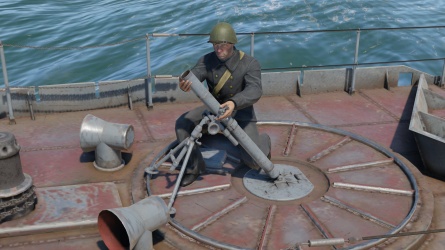BM-37 mortar

Contents
Description
Write an introduction to the article in 2-3 small paragraphs. Briefly tell us about the history of the development and combat using the weaponry and also about its features. Compile a list of air, ground, or naval vehicles that feature this weapon system in the game.
Vehicles equipped with this weapon
General info
Tell us about the tactical and technical characteristics of the bomb.
Effective damage
Describe the type of damage produced by this type of bomb (high explosive, splash damage, etc)
Comparison with analogues
Give a comparative description of bombs that have firepower equal to this weapon.
Usage in battles
Describe situations when you would utilise this bomb in-game (vehicle, pillbox, base, etc)
Pros and cons
Summarise and briefly evaluate the weaponry in terms of its characteristics and combat effectiveness. Mark pros and cons as a list.
Pros:
Cons:
History
An old but reliable weapon, the humble mortar has been a staple of siege warfare, but it would find a new, but important role during the First World War. The mostly static trench warfare on the Western Front rendered most direct-fire weapons of limited utility against dug-in opponents, leading to the recognized need for more indirect-fire weapons. The sudden need for mortars for the trenches led to the development of an infantry portable mortar by Fredrick Wilfred Stokes for the British Army which was called the 3-inch Stokes Mortar but was actually 81 mm (3.2-inches) in calibre. The Stokes was an influential weapon and after World War I, the 81 mm was adopted as the standard calibre for infantry mortars in multiple nations around the world.
The Soviet Union was not one of these nations, however. They instead adopted an 82 mm mortar round that allowed them to use captured enemy munitions that were 81 mm in calibre but denied the ability for the enemy to do the same with Soviet mortar rounds. Around the same time, the Stokes mortar evolved thanks to French weaponsmith Edgar Brandt who refined the Stokes first in 1927 and again in 1931. The Brandt Mle 27/31 was adopted by the Armée de Terre (French Army) and soon became a design that was licensed or otherwise copied by almost every nation that would serve in World War II. The Soviets were no exception despite their different calibre and adopted a modified copy of the Brandt Mortar in 1936 as the BM-36 which was soon modified to create the BM-37 the following year.
The BM-37 differs from the early BM-36 from a round baseplate instead of the earlier square baseplate, simpler sights, new traverse, and elevation controls, and shock absorbers on the bipod to reduce relaying time. Issued as an infantry mortar on the battalion level, the BM-37 was still in common use by the time of World War II and was the main mortar for the Red Army during the early years of the war. By around 1943, a number of mortars were lost in combat leading to the widespread adoption of the PM-41 as a replacement. The BM-37 was planned for the MBK-161-class of armoured riverboats but was dropped from the design. The Soviets later developed the M-37-M variant with a removable baseplate and redesigned it to avoid double-loading the mortar. The BM-37 was also licensed in China as the Norinco Type 53 which was also used in Bangladesh, Tanzania, Uganda, and Vietnam. It was licensed and used as the Helwan Machine Tools Company Model 69 in Egypt and the Bulgarian Arsenal M-82 Mod 1937.
Media
Excellent additions to the article would be video guides, screenshots from the game, and photos.
See also
External links
Paste links to sources and external resources, such as:
- topic on the official game forum;
- other literature.
| Naval special armaments | |
|---|---|
| USA | |
| Mortars | 7.2-inch T37 · Mk 2 |
| Rockets | 5-inch GPSR Mk.7 · Mark 108 Weapon alfa |
| Missiles | RIM-24A |
| Germany | |
| Rockets | M/50 Bofors |
| Missiles | Strela-2M |
| USSR | |
| Mortars | BM-37 · RBM · RBU-1200 · RBU-2500 · RBU-6000 · RKU-36U |
| Rockets | BM-14-17 · BM-21 · M13 · M-8 |
| Missiles | Volna-M |
| Britain | |
| Mortars | Ordnance ML 4.2-inch mortar |
| Japan | |
| Rockets | 4.5-inch BBR Mk.7 (USA) · Mark 108 Weapon alfa (USA) |
| Italy | |
| Missiles | Nettuno |
| France | |
| Missiles | SS.11 |



